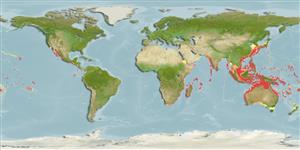Common names from other countries
Environment: milieu / climate zone / depth range / distribution range
Écologie
marin récifal; profondeur 10 - 132 m (Ref. 9710). Tropical
Indo-West Pacific: East Africa south to the southeast coast of South Africa (Ref. 5469) and east to Tonga (Ref. 53797), north to southern Japan, south to New Caledonia, southeastern Australia and northern New Zealand.
Taille / Poids / Âge
Maturity: Lm ? range ? - ? cm
Max length : 15.0 cm TL mâle / non sexé; (Ref. 559)
Description synthétique
Clés d'identification | Morphologie | Morphométrie
Épines dorsales (Total) : 10; Rayons mous dorsaux (Total) : 16 - 17; Épines anales: 3; Rayons mous anaux: 6 - 7. Body mottled light yellowish to orange-brown; juveniles orange-gold (Ref. 5469).
Found on steep slopes and around small coral heads exposed to currents (Ref. 9710). Hovers several meters above the bottom and feeds mainly on pelagic crustaceans, copepods, and other animals of the plankton. Also found around sponges (Ref 90102).
Life cycle and mating behavior
Maturities | Reproduction | Spawnings | Egg(s) | Fecundities | Larves
Further histological evidence is needed to establish protogyny (Ref. 103751).
Randall, J.E., G.R. Allen and R.C. Steene, 1990. Fishes of the Great Barrier Reef and Coral Sea. University of Hawaii Press, Honolulu, Hawaii. 506 p. (Ref. 2334)
Statut dans la liste rouge de l'IUCN (Ref. 130435)
CITES (Ref. 128078)
Not Evaluated
Menace pour l'homme
Harmless
Utilisations par l'homme
Pêcheries: commercial; Aquarium: Commercial
Outils
Articles particuliers
Télécharger en XML
Sources Internet
Estimates based on models
Preferred temperature (Ref.
115969): 20 - 28.3, mean 26.8 (based on 500 cells).
Phylogenetic diversity index (Ref.
82804): PD
50 = 1.0000 [Uniqueness, from 0.5 = low to 2.0 = high].
Bayesian length-weight: a=0.01585 (0.00637 - 0.03944), b=3.01 (2.79 - 3.23), in cm Total Length, based on LWR estimates for this (Sub)family-body shape (Ref.
93245).
Niveau trophique (Ref.
69278): 3.2 ±0.31 se; based on food items.
Fishing Vulnerability (Ref.
59153): Low vulnerability (10 of 100).
